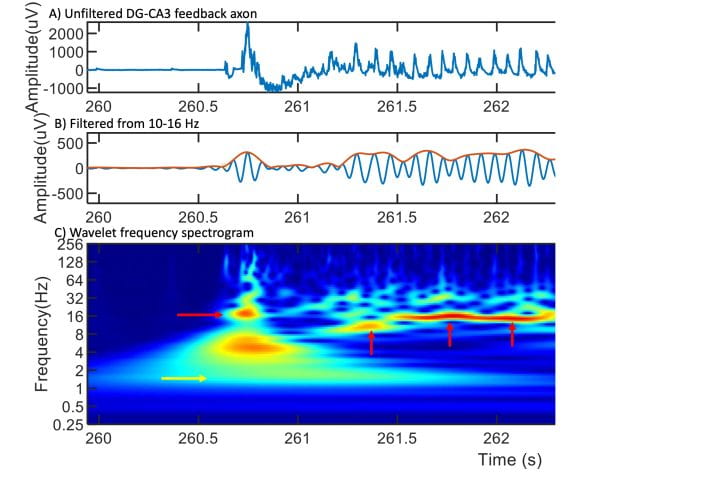UC Irvine researchers find new origin of deep brain waves
Knowledge of hippocampal activity could help improve sleep and cognition therapies

Irvine, Calif., April 10, 2024 — University of California, Irvine biomedical engineering researchers have uncovered a previously unknown source of two key brain waves crucial for deep sleep: slow waves and sleep spindles. Traditionally believed to originate from one brain circuit linking the thalamus and cortex, the team’s findings, published today in Scientific Reports, suggest that the axons in memory centers of the hippocampus play a role.
For decades, slow waves and sleep spindles have been identified as essential elements of deep sleep, measured through electroencephalography recordings on the scalp. However, the UC Irvine-led team revealed a novel source of these brain waves within the hippocampus and were able to measure them in single axons.
The study demonstrates that slow waves and sleep spindles can originate from axons within the hippocampus’ cornu ammonis 3 region. These oscillations in voltage occur independently of neuronal spiking activity, challenging existing theories about the generation of these brain waves.
“Our research sheds light on a previously unrecognized aspect of deep sleep brain activity,” said lead author Mengke Wang, former UC Irvine undergraduate student in biomedical engineering who is now a graduate student at Johns Hopkins University (Wang conducted the study while at UC Irvine). “We’ve discovered that the hippocampus, typically associated with memory formation, plays a crucial role in generating slow waves and sleep spindles, offering new insights into how these brain waves support memory processing during sleep.”
The team utilized innovative techniques – including in vitro reconstructions of hippocampal subregions and microfluidic tunnels for single axon communication – to observe spontaneous spindle waves in isolated hippocampal neurons. These findings suggest that spindle oscillations originate from active ion channels within axons, rather than through volume conduction as previously thought.
“The discovery of spindle oscillations in single hippocampal axons opens new avenues for understanding the mechanisms underlying memory consolidation during sleep,” said co-author Gregory Brewer, adjunct professor of biomedical engineering. “These findings have significant implications for sleep research, potentially paving the way for new approaches to treating sleep-related disorders.”
Brewer’s other research affiliations include the Institute for Memory Impairment and Neurological Disorders and the Center for Neurobiology of Learning and Memory.
By uncovering the hippocampus’s role in generating slow waves and sleep spindles, this research expands our understanding of the brain’s activity during deep sleep and its impact on memory processing. The findings offer a promising foundation for future studies exploring the therapeutic potential of targeting hippocampal activity to improve sleep quality and cognitive function.
Joining Brewer and Wang in this study, which received financial support from the UCI Foundation, were William Tang, professor emeritus of biomedical engineering; Bryce Mander, associate professor of psychiatry & human behavior; and Samuel Lassers, graduate student researcher in biomedical engineering.
UC Irvine’s Brilliant Future campaign: Publicly launched on Oct. 4, 2019, the Brilliant Future campaign aims to raise awareness and support for the university. By engaging 75,000 alumni and garnering $2 billion in philanthropic investment, UC Irvine seeks to reach new heights of excellence in student success, health and wellness, research and more. The Henry Samueli School of Engineering plays a vital role in the success of the campaign. Learn more at https://brilliantfuture.uci.edu/the-henry-samueli-school-of-engineering/.
About the University of California, Irvine: Founded in 1965, UC Irvine is a member of the prestigious Association of American Universities and is ranked among the nation’s top 10 public universities by U.S. News & World Report. The campus has produced five Nobel laureates and is known for its academic achievement, premier research, innovation and anteater mascot. Led by Chancellor Howard Gillman, UC Irvine has more than 36,000 students and offers 224 degree programs. It’s located in one of the world’s safest and most economically vibrant communities and is Orange County’s second-largest employer, contributing $7 billion annually to the local economy and $8 billion statewide. For more on UC Irvine, visit www.uci.edu.
Media access: Radio programs/stations may, for a fee, use an on-campus ISDN line to interview UC Irvine faculty and experts, subject to availability and university approval. For more UC Irvine news, visit news.uci.edu. Additional resources for journalists may be found at https://news.uci.edu/media-resources/.